
Photo from wikipedia
The shear behavior of 8 high-strength concrete full-scale deep beams with high-strength steel bars was studied. The depth beam size was 100 mm × 900 mm × 2200 mm, the… Click to show full abstract
The shear behavior of 8 high-strength concrete full-scale deep beams with high-strength steel bars was studied. The depth beam size was 100 mm × 900 mm × 2200 mm, the test parameters included the shear span-to-depth ratio (λ = 0.9, 0.6, 0.3), longitudinal reinforcement ratio (ρs=0.66%, 1.06%, 1.26%) and stirrup reinforcement ratio (ρsv = 0, 0.26%, 0.34%, 0.5%). The ratio of the cracking load of the inclined section to the ultimate load is between 30% and 50%, and the bending deformation of the deep beam is small, showing the characteristics of brittle failure for deep beams. Under the action of a concentrated load, the failure mode of deep beams with a small shear span ratio is the failure of the diagonal compression struts, which is very different from that of shallow beams with a large shear span ratio. With the increase of shear span ratio from 0.3 to 0.9, the ultimate shear capacity of deep beams decreases by 19.33%. With the increase of longitudinal reinforcement ratio from 0.67% to 1.27%, the ultimate shear capacity of deep beams increased by 45.02%. With the increase of vertical stirrup reinforcement ratio from 0% to 0.5%, the ultimate shear capacity of deep beams increased by 8.93%. Increasing the area of longitudinal bars or stirrups limited the transverse tensile strain of the compression struts, which is conducive to improving the compressive strength of the compression struts of deep beams and then improving the bearing capacity of deep beams. The strut-and-tie model (STM) is more suitable for analyzing the shear capacity of deep beams. The calculation methods for calculating the shear capacity of deep beams were compared with ACI 318-19, CSA A23 3-19, EN 1992-1-1:2004, Tan–Tan model, Tan–Cheng model, softened STM (SSTM) and simplified SSTM (SSSTM). The results showed that the shear capacity of deep beams could be well predicted by reasonably determining the STM parameters.
Journal Title: Materials
Year Published: 2022
Link to full text (if available)
Share on Social Media: Sign Up to like & get
recommendations!